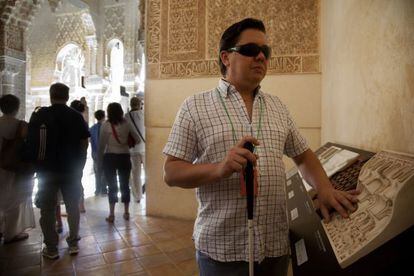The Alhambra that eyes cannot see
Carlos Marín, who is blind, takes EL PAÍS on a unique tour of the Granada palace A new app will also bring previously hidden areas of the complex to light

It may be true that there is nothing worse than the misfortune of being blind in Granada, as the popular saying goes. But Carlos Marín, a sightless resident of the city that is home to the Alhambra, says that it is possible to appreciate this UNESCO World Heritage Site using touch and hearing.
"The most important thing is the temperature - each area is different. The marble is cold, unlike plaster or wood, which is warmer," he says. "And the echoes tell you whether you are in a closed room, a narrow space, or in the open air. The marble produces an echo, while the plaster, and above all the wood, absorb sound," he explains.
We cross the Mexuar, the first stop on our tour of the palace complex. "This is a very welcoming space, with a brick floor, which distributes sound," he says, noting the coming and going of other tourists. Marín reaches the Hall of the Ship, one of the five points in the Alhambra with tactile reproductions of the decorations.
He passes his fingers along a panel of mosaics and plaster molding. "It's only by touching these details and shapes that one can get a real idea of them; an explanation in itself is not enough. It's like being able to bring a blurred image into focus," he says. Marín's ability is helped by not having been born blind: he lost his sight in a car accident 23 years ago when he was aged 20, and is still able to remember images from a childhood visit to the Alhambra, but says that even those born blind can create their own images in their mind's eye, "by touching these decorative reproductions."
The marble produces an echo, while the plaster and wood absorb sound"
Braile explanations are also available for the blind. But the recreations help the sighted to get a better understanding of the wonders of the Alhambra, given that it is forbidden to touch the real thing: the temptation to run your fingers along a mosaic and literally be in touch with history keeps the security staff ever vigilant.
Marín moves on to a panel with ceramic tracing. "It feels like a jigsaw puzzle," he says, turning to run his fingers across a segment of intricately carved wood. "I can feel where the different pieces are joined together, like a picture frame. Wood is warm, it is the most pleasant to touch," he adds.
The visit continues along the passages that connect the Hall of the Abencerrajes with the Patio of the Lions.
"You can tell that we are in a passage, it feels much tighter," he says, noting the echo bouncing off the walls. When we reach the Patio of the Lions, the sound of the water trickling from the fountain becomes audible. "The water also tells you a lot: according to the sound of it falling you can judge the height of the source, and it gives you an idea of how it has been designed. I can hear the water as it runs down through the channels from one side to the other of the patio."
Aided by his folding walking stick - "It's an extension of my finger," he says - Marín makes his way around the water channels, up the stairs, and through the hordes of other visitors toward the Lindaraja Garden, and on to the Partal. "I can sense that there is a wall on one side, and on the other side I hear a fountain, but the sound isn't coming directly to me, I can't focus on it." Marín says that sounds, like images, need to be focused. "There is something in the way that is partially blocking the sound, maybe it's a garden with trees," he says, correctly identifying the reason.
Alongside the Patio of the Lions, in the Hall of the Mocárabes, is another of the touch panels. "It is impossible to get any idea of what the decorations are like unless you touch them, even for a sighted person, because they are so high." He is able to sense the height of the ceilings from the echoes, "and the detail cannot be fully appreciated."
It's only by touching these details and shapes that one can get a real idea of them"
Another panel has a fragment of a carved wooden screen: "I can feel the shape of a star." He then touches a ceramic tile: "There are concentric patterns that get bigger, expanding outward."
A trip to the Alhambra is still a rewarding experience, even for the blind, says Marín.
The Alhambra attracts around two million visitors a year, according to the Patronato de la Alhambra in Spain, the organization that looks after the complex. Visitors to the Alhambra can now use a special app that uses technology to bring previously hidden areas of the complex to light. The Hidden Alhambra aims to expand the site for tourists. It will allow visitors to virtually explore delicate, closed-off areas on their smartphones and tablets, as well as opening up new routes to related areas outside the complex.
The World Monuments Fund is also contributing more than 300,000 euros to the conservation of the Oratorio del Partal, an elaborate mid-14th century chapel built during the reign of Yusuf I. The conservation effort will include work on the roof, carved wood ceiling and decorative plaster work and will be incorporated into the Hidden Alhambra application.
The Alhambra is further expanding its activities by opening a school that aims to become an international center of excellence in the field of conservation.
The Alhambra School is due to open its doors in October 2014, and will offer a range of qualifications in restoration taught by some of the world's leading experts on Islamic art.










































